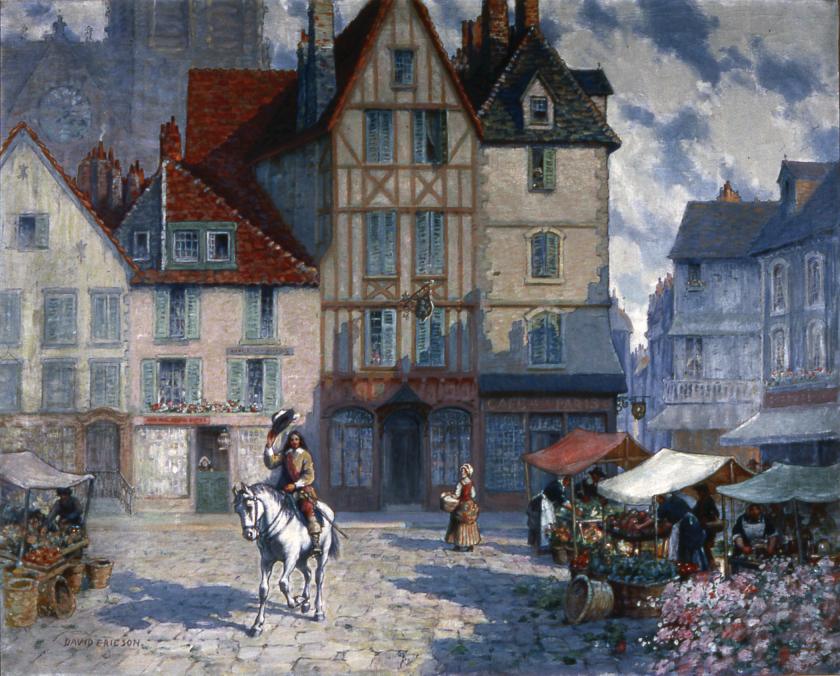By the time the Zenith City first became a city in March 1870, people had been calling the community centered on the base of Minnesota Point “Duluth” for 14 years.
How did Duluth become “Duluth”? With a picnic, of course.
The name Duluth first appeared in print in 1856. That year surveyor Richard Reif finished platting a townsite at Lake Superior’s western-most tip on behalf of proprietors Joshua Culver, Orrin Rice, Robert Jefferson, and brothers George and William Nettleton. It sat between Third Avenue East and Eighth Avenue West, from First Street south to roughly Buchanan Street in today’s Canal Park business district.
Recollections of early Duluthians tell that the town received its name at a picnic on Minnesota Point organized by the Nettleton brothers on a lovely summer day in 1856 where “various names for the new town were proposed and Mr. Wilson at last proposed ‘Duluth.’”
Mr. Wilson was the Rev. Joseph Gaston Wilson, a native of Ohio who had arrived in Superior the previous year to teach at the Presbyterian Sunday School. Wilson is credited for giving the second Christian sermon in what is now Duluth in October 1855 in a log boarding house in Oneota townsite (now a West Duluth neighborhood).
ADVERTISEMENT
Wilson was well prepared. The Nettletons had offered him two lots in their new town if he could find an appropriate name for it. On George Nettleton’s bookshelf Wilson discovered an English translation of a book by Jesuits describing the efforts of French missionaries and explorers in North America. There he read about the exploits of Daniel Greysolon Sieur du Lhut, who once proclaimed that he “feared not death, only cowardice and dishonor.”

Du Lhut was an ambitious and often arrogant 17th-century French soldier described by friends (and himself) as an adventurous diplomat — and by rivals as a scrupleless outlaw. Unlike the French voyageurs and missionaries, du Lhut came to western Lake Superior seeking neither fur nor converts. He wanted to make a name for himself, either by discovering a water passage to the Pacific Ocean or by bringing the Ojibwe and Dakota together to ensure the Dakota would partner with the French in the fur trade — or both.
While du Lhut never ventured further west than Lake Mille Lacs, he is traditionally credited for arranging the 1679 Dakota-Ojibwe gathering at Fond du Lac that began a 57-year alliance between the tribes.
He was also accused by another French explorer, René-Robert Cavelier Sieur de La Salle, of being “king of the outlaws” for entering the Lake Superior region without a license to trade. Several historians suggest LaSalle’s accusation was caused by petty jealousy, and that du Lhut’s contemporaries considered him “a very honest man.”
Perhaps Wilson settled on du Lhut as a namesake because the Frenchman had actually been to “Duluth.” In 1679 he and a small party of French and Ojibwe reached Minnesota Point, carrying their canoes across the sandbar along a path near its base that the Ojibwe called Onigamiinsing (Little Portage).
Wilson’s audience likely sat on blankets not far from where du Lhut had portaged. Reif platted the path as Portage Street, and beginning in 1870 it was carved out of the sandbar and widened to become the Duluth Ship Canal.
ADVERTISEMENT
Wilson’s tale of du Lhut’s adventures and his anglicized suggestion of “Duluth” were enthusiastically received by the community’s early claim holders. Witnesses remembered anointing the choice with the popping of champagne corks and a toast, as the sun set, to Duluth, destined to become “Queen of the West.”
Wilson got his land, but he never made a home in the town he had named. He left, as did most others, after the Financial Panic of 1857. By 1860 he was living in Terre Haute, Indiana, and 10 years later he was editing and publishing a Presbyterian newspaper in Fort Madison, Iowa, where he died in 1886.
So if Duluth is named for Daniel du Lhut, who is Jean Duluth Road named for? Duluth researcher Heidi Bakk-Hansen found that the 1876 edition of Johnson’s Universal Cyclopaedia claimed that the city was named for “Capt. John Duluth … who visited the country and built a hut in 1760.”
It was a piece of pure fiction written by Duluth Herald editor Robert D’Unger. Within a year local journalists had Francisized “John” to Jean and by 1903, when it was used for the new Jean Duluth Farm, it had become widespread. The road was named for the farm, not for Duluth’s namesake.
Happy 150th birthday, city of Duluth!
Editor's note: This story is adapted from the forthcoming book “Duluth: An Urban Biography,” by Tony Dierckins (Minnesota Historical Society Press, April 2020); signed copies available for preorder at zenithcity.com .







